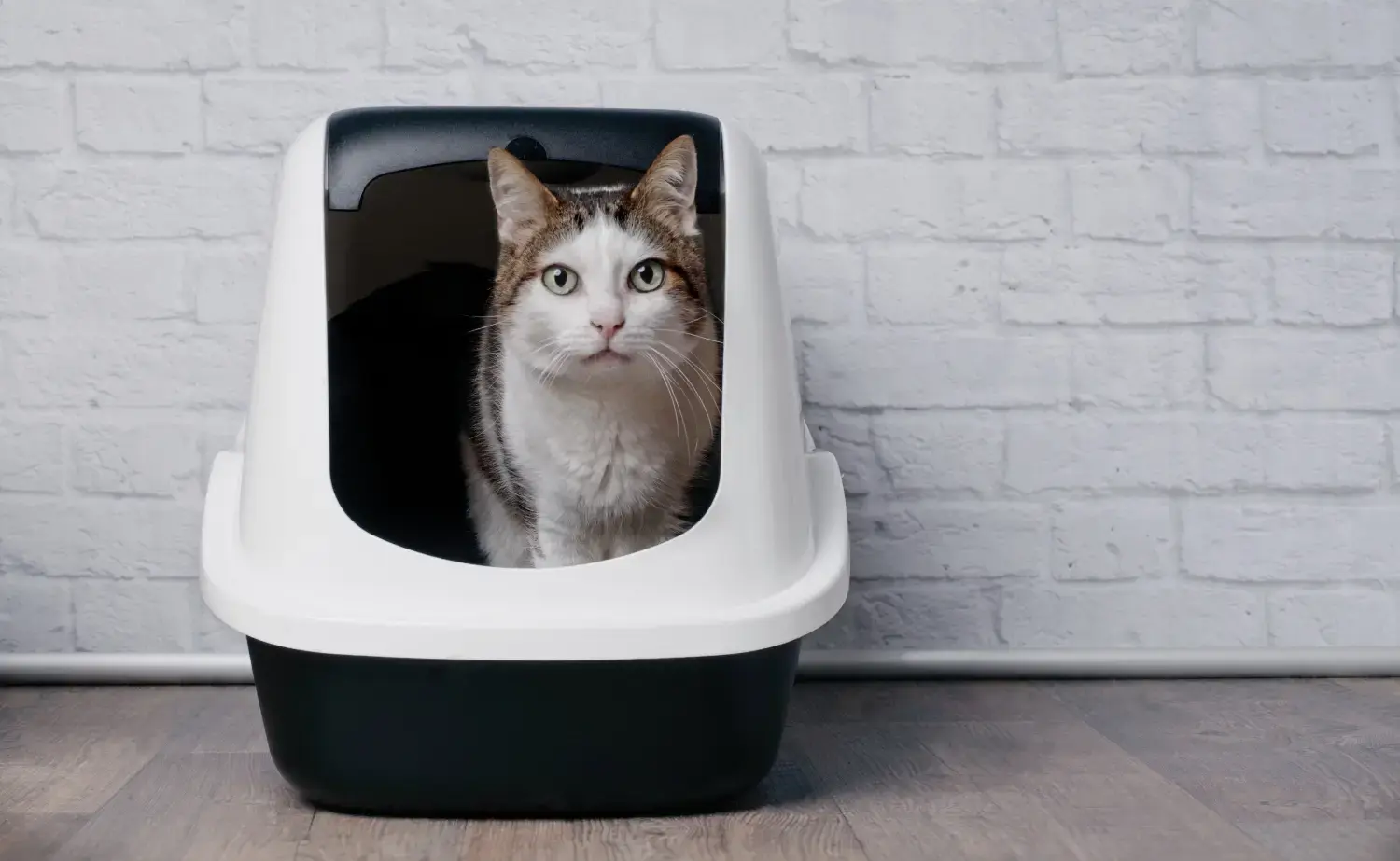
Is your cat peeing outside the litter box? Sometimes new kittens, and even old cats, struggle with bad bathroom habits. We put together some tips for how to litter train your cat and stop your cat from peeing outside the litter box.
Wondering how to train your kitten to use the litter box? Learning how to litter box train your cat is not too difficult, but it does take time and practice.
Kittens often learn basic litter habits from their mom and litter mates, but you may still need to train some better habits once you get them home.
Even adult cats sometimes need a refresher on clean and healthy bathroom habits. Bad habits are quickly learned and hard to get rid of, so read on to get tips on how to litter train your cat, how to stop your cat from peeing outside the litter box, and how to keep your cat litter box clean and safe.
Why Do Cats Use Litter Boxes?
Your sweet little kitten or house cat is not that far removed from their wild ancestors. The instinct to use a litterbox is a part of the feline's DNA.
Yes, cats are obsessive groomers, but that’s not why they like to hide their business. Cats actually cover their urine and excrement as a survival mechanism.
The instinctual act of burying their waste is a way for the cat to cover their tracks and prevent them from being eaten by predators. Hiding their body waste masks their scent. In the wild, cats prefer soft dirt or sand to bury their waste, so they are naturally drawn to the sandy consistency of cat litter. How do I make my kitten use the litter box?
When a kitten feels the cat litter under its paws, instinct kicks in, and the cat starts to dig and bury their waste. In most cases, kittens learn basic litter habits from their mother and siblings, so even young kittens know the fundamentals of litter box training before you bring them home.
Essentials for Litter Training Your Cat
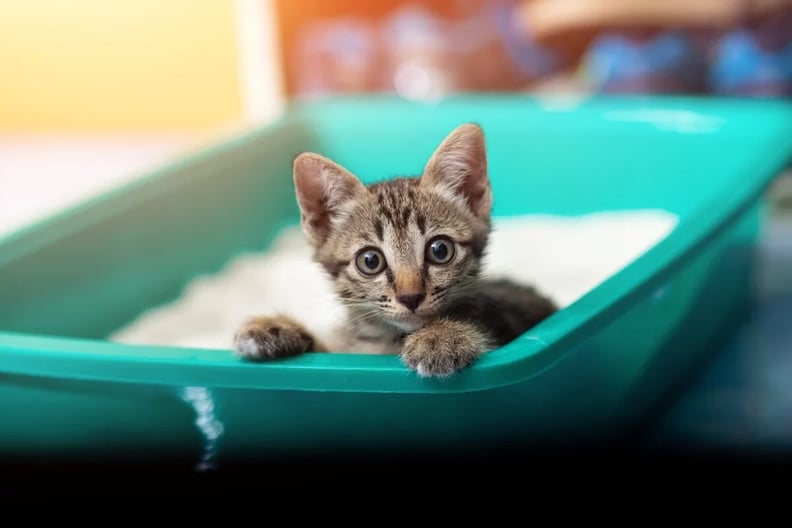
Before you start litter box training, you'll want to have all the correct supplies on hand to make litter training your cat a breeze. There are a few essentials that every cat mom should start with and a few extras for kitties who need a little extra help.
All of these are essential to building good litter box habits and keeping your kitten’s litter clean and safe. Choosing the right gear for you and your kitten could have a huge impact on the success of your litter training process.
Best Litter Box for Litter Training a Kitten
To teach your kitten good litter habits, you need to start off with the right supplies. There are many different types of litter boxes available, but the one you choose for litter training needs to match your kitten's size and preferences, as well as the space you have available for your kitten's bathroom needs.
You'll need to purchase one or two litter boxes. Ideally, each cat in the household should have a litter box plus one extra. If you have a single cat, then you'll want to buy two litter boxes, but if you have two cats, then you'll need three litter boxes. If you have three cats, then make sure you have four litter boxes. You get the gist.
Choosing the right type of litter box can make all the difference when it comes to litter training your new cat. If your kitten seems to have lost her litter box knowledge as soon as you bring her home, then your litter box might be the problem.
Here are the basic litter box styles you can choose from:
Basic Litter Pans
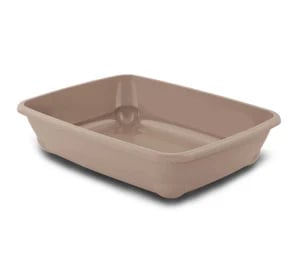 A standard short-sided litter pan, like the Bergamo Birda Litter Pan, is a great starter option. For young kittens who are still learning how to use the litter box, short sides make it easier for little legs to get in and out. The open style is also less intimidating to cats who are nervous about enclosed spaces.
A standard short-sided litter pan, like the Bergamo Birda Litter Pan, is a great starter option. For young kittens who are still learning how to use the litter box, short sides make it easier for little legs to get in and out. The open style is also less intimidating to cats who are nervous about enclosed spaces.
Also, consider the size of the litter pan. If a litter box is too small, your kitten might refuse to use it or may urinate over the side of the box unintentionally.
High-Sided Litter Pans
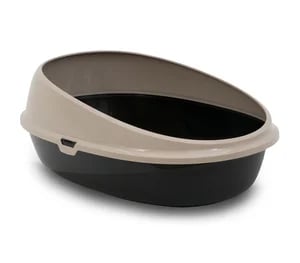 Cats that like to cover their droppings very thoroughly may have a tendency to kick litter over the sides of the pan and leave a mess for you. A high-sided litter pan will allow your overzealous kitty to kick and cover to their little heart's content without making a mess of their litter area.
Cats that like to cover their droppings very thoroughly may have a tendency to kick litter over the sides of the pan and leave a mess for you. A high-sided litter pan will allow your overzealous kitty to kick and cover to their little heart's content without making a mess of their litter area.
Opting for a high-sided or framed litter pan, like the Arm & Hammer Rimmed Wave Litter Pan, can help reduce how much litter (or worse) leaves the litter box. Just make sure the entrance to the box isn't too tall. Smaller kittens may not be graceful enough yet to get in and out of this tall pan, and it could prevent them from using it.
Hooded Litter Boxes
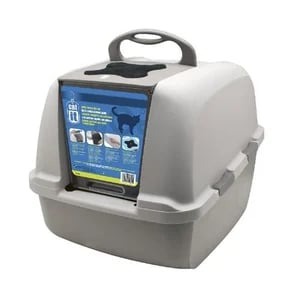 The most preferred style of litter box for most cat families is a hooded litter box. These have a detachable covering and a flap door that not only keeps the litter inside but also helps to contain the smell.
The most preferred style of litter box for most cat families is a hooded litter box. These have a detachable covering and a flap door that not only keeps the litter inside but also helps to contain the smell.
While this style is great for you, not all cats like having their bathroom feel so confined. Make sure you choose an appropriately sized litter box, like the Catit Jumbo Hooded Litter Box, so that your cat can move freely and comfortably.
Best Type of Cat Litter for Litter Training

Walk through any cat supply section of your local pet store, and you'll probably be overwhelmed with the wide assortment of kitty litter types. You'll find clumping, non-clumping, biodegradable wood or paper pellets and crystals, just to name a few.
Most people think that litter is litter, but different smells and textures may turn your cat off from using her litter box and create some unwanted and unsanitary litter habits. Some cats prefer one type over the other, and you may need to try a few before you find the right one.
There are many different types of cat litter, each with their own pros and cons. Before you make a choice, take a look at the benefits and best practices of each of these cat litter types. How they are used, cleaned, and maintained can help you narrow down your choices.
Best Clay Cat Litter
Clay is the most common type of cat litter. It’s cheap and easy to find, and the texture is usually well-accepted by most cats and kittens. Clay litter is what most cat parents are used to, but there are concerns about the quality and safety of some clay litter.
Look for a high-quality clay litter that is 99% dust-free. A high-quality clay litter is made from sodium bentonite clay and contains little to no filler ingredients. Bentonite clay is natural and highly absorbent, which makes it useful as a cat litter.
Here are some of our most popular clay litters for kitten litter training:
Best Natural Cat Litter
Natural cat litter is a popular alternative to traditional clay litter. These are made from natural ingredients like corn or wheat, and while they do have a different texture, they are often just as absorbent as clay. They also don't have the same dust issues as clay litter, making them safer.
The texture is often similar to clay, or even finer, giving the litter a very comfortable paw feel. This is great for kittens who are sensitive or just nervous about the litter box. The texture also makes learning to cover their waste easier.
You won't be disappointed by our favourite natural cat litter brands:
Best Pellet Cat Litter
Pellet litter is a type of natural litter that is known for its extremely high absorbency. They are usually made from wood, like pine, or recycled paper. This type of litter is a very environmentally friendly choice for pet owners who worry about all the clay litter that clutters our landfills.
The pellets are tightly packed and very absorbent, which means virtually no odour and zero dust. This is a non-clumping style of litter, so instead of scooping, you dump the whole tray and fill it with fresh litter each week. You can still scoop out poop, but the urine will disappear into the pellets.
Take a look at our top-selling pellet cat litters:
Best Crystal Cat Litters
Another non-clumping litter option is silica cat litter. These beads or crystals can hold up to 40 times their weight in liquid, so they are great for controlling urine odours, even superior to other non-clumping litters.
One drawback of crystal litter is the texture. While some are formed into smooth, large beads, others are smaller crystals that feel sharp to the touch. They aren’t sharp enough to cut your kitten's paws, but they may deter an inexperienced kitten from using the litter.
Must-Have Litter Accessories
In litter training your cat, you also need to train good litter maintenance habits in yourself. Keeping a clean and safe bathroom area for your cat will help to encourage and reinforce good litter habits. To do so, you should invest in the right tools to make litter box cleaning easy.
If you can't commit to keeping a clean litter area for your cat, you can't expect them to be cooperative when trying to push better bathroom habits on them. There area few must-have tools that will help make litter box maintenance easy and less yucky.
Scoop
Whether using clumping or non-clumping cat litter, you'll want a scoop to sift through the waste and dispose of it. They come in a variety of sizes and shapes. Smaller grated scoops are good for fine-clumping litter, as they only allow loose pieces of the litter to fall back into the litter tray and catch clumps of waste.
If you use a non-clumping litter, like pellets, scoops with wider slots work well, allowing the pellets to fall through and catch pieces of stool and swelled pellets that are too large to fit through.
Litter Mat
Cats are meticulous groomers and hate being dirty. It’s no surprise that they prefer a clean litter area, and frankly, so do you. This is why the right litter mat can be a useful tool to help your cat get used to her bathroom.
Litter mats catch litter as your cat leaves the box. Whether your cat likes to kick a little too fervently when they are covering their waste or if some litter sticks to their furry paws, the mat will help reduce how much litter tracks around your house.
Litter Disposal Systems
Daily scooping is necessary to keep your cat's bathroom appealing to them, so make disposal easier with a litter disposal system like the Litter Genie. These large capacity pails can hold 8 days' worth of waste for one cat and help to lock odours and bacteria away.
Cat Stain and Odour Removers
During the training process, accidents are going to happen. If you don't clean up the odours left behind properly, your cat may learn some bad bathroom habits that will be very difficult to train out of them.
Make sure to keep a cat stain and odour remover on hand that will get out strong cat litter smells as well as pheromones that cats use to mark territory. By completely eliminating the evidence, your cat will be less likely to return to the same spot over and over.
Litter Box Cleanliness Tips
It's essential to keep your cat's litter box clean, especially if you are trying to figure out how to get your cat to stop peeing everywhere. Many cats stop using the litter box if they feel that the spot is not clean enough.
Remember, cats are spotless animals, and they are also survivalists. If the cat believes the litter box is filthy or smells, it could attract predators, putting the cat's life at risk, so they may find somewhere less conspicuous to relieve themself.
Here are some pro tips for keeping your cat’s litter box clean and safe.
Scoop Daily
Scoop the cat's litter box at least once a day. Ideally, you should scoop several times per day to ensure that the kitty always has a fresh box. Many cats will not use the litter box if they feel it is too dirty.
Think of scooping the litter box like flushing the toilet. After one or two trips to the bathroom, the litter box is going to be pretty gross. Every cat has their own threshold of what is too dirty, but if your kitten is just learning or if your adult cat is displaying some unwanted bathroom habits, then a dirty litter box is very likely part of the problem.
Sanitize Weekly
Scooping removes clumps and soiled litter, but it doesn't remove all the bacteria. Completely emptying the litter box and sanitizing it before refilling it with fresh litter is the best way to minimize bacteria in your cat's environment. A dirty litter box can contribute to urinary tract infections in cats.
Avoid harsh cleaners like bleach and stick to natural and cat-safe cleaning agents like vinegar to disinfect and deodorize. Once cleaned and dried, add new litter to the box and dispose of the old stuff.
Top Up As Needed
Every time you scoop, you will be removing litter. In between litter box deep cleans, it's important to top up the litter to an optimal level. Most cats prefer 2-3 inches of litter to give them plenty of extra to kick and cover their waste with. Too little cat litter in the pan and your cat may not feel comfortable using it or may not bother to cover their litter.
How to Potty Train a Cat
Just because your kitten learned a thing or two about the litter box doesn’t mean they have mastered the skill. It’s not uncommon for new kittens to need a little direction and training to get them used to using the litter box properly in their new home. Best way to litter train a kitten.
To help your cat build good litter box habits, you’ll need the right tips and tools to help your kitten learn appropriate and consistent bathroom behaviours. More often than not, kittens pick up these skills very quickly but be prepared for a setback or two along the way.
To help you get started, we put together some tips for how to litter train your cat.
Litter Training Your Cat in 5 Simple Steps
Once you bring the kitty home and have all the supplies, one of the first things you should do is start the litter training process. Most cats already know the fundamentals but need help building good habits.
Regardless of how new your kitten is to litter training, starting from the basics is always recommended.
- Start with a Clean Litter Box and Fresh Litter: Whether you are training a new kitten or re-educating an older cat that has learned some bad litter habits, it's important to start of with a clean and sanitized litter box and fresh litter. Odours from other cats or from previous bathroom visits can be off-putting for a cat that needs a fresh start.
- Introduce the Litter Box: This may seem unnecessary, but anytime the litter box is cleaned or moved, it's a good idea to show your kitty. Don't force them into the litter box. Instead, just make sure they always know where it is and that it's clean and easy to access.
- Pick the Right Spot: Location is important when it comes to litter training. You probably want the litter box out of the way, maybe even hidden from guests and high-traffic areas of your home. While we can certainly understand, having the litter box tucked away in a closet or basement may discourage your kitten from using it. You also don't want to choose an extremely high-traffic area of the home. No one wants an audience while they poop, and that includes your kitten.
- Bring Your Kitten to the Litter Box Often: Build a good bathroom routine by taking your kitten to the litter box routinely. After meals, after playtime, and even after a little kitty nap, take her to the litter box. If she uses it, make sure to reward her with praise and some tasty cat treats.
- Don’t reprimand mistakes: We know it’s frustrating when your cat pees on the carpet or on your clean laundry, but cats don’t respond well to getting yelled at, and even worse to being physically corrected. Instead, bring your cat immediately to the litter box to reinforce the appropriate place to relieve themself.
Don't expect perfection overnight. Young kittens that are just learning and older cats that are already used to their bad bathroom habits will take time and patience to master good litter box etiquette. Be consistent and make sure to reward success, no matter how small.
If bad litter habits persist, it's a good idea to contact your vet to rule out an underlying health issue. Urinary tract infections and kidney problems can both have a direct and sudden impact on bathroom habits.
Litter Box Training Tips for Stubborn Cats

Cats learn differently than dogs, so training a stubborn cat may take time. Once you have ruled out a health issues, the most important thing is to stick to a routine and be consistent. Some cats, especially older cats that need help re-learning their litter box skills, might be a little more stubborn and need some extra help.
Here are a few tips that might help you successfully litter box train your cat or kitten:
-
- Keep the litter box clean. This means scooping every day, replacing litter routinely, and sanitizing the litter box. Even your cat’s own dropping and scent could cause her to not want to use the box.
- Stick with the same type and brand of litter that your cat or kitten is used to using. If you are bringing home a new kitten, then be sure to find out what type of cat litter the kitten has been trained to use. The change could be enough to cause problems.
- If your cat is not responding well to the litter that they’ve used in the past, try different types of cat litter to determine which brand or type your cat prefers best. You'll also want to factor in depth. Some cats prefer only a few inches of litter, and others like more.
- Have a litter box on all levels of the home if you live in a multi-storied home. Some senior cats or kittens won't want to traverse multiple floors in a home to reach the litter box, so a litter pan should always be readily accessible for all cats in the household.
- Try using a cat attractant litter, such as Dr. Elsey's Cat Litter Attractant. This can help your cat learn where the appropriate place to go to the bathroom is.
The goal is to make the litter box as easy as possible for your cat. If they have to work too hard to find or use the litter box, you can expect them to find an easier, and unfortunately, messier solution.
How to Stop Your Cat from Peeing Outside the Litter Box
Is your cat urinating outside the litter box? Sometimes cats that have had years of practice using the litter box appropriately suddenly start to develop bad litter box habits. Learning why your cat is peeing outside the litter box is the first step toward stopping this unpleasant behaviour.
Nicholas Dodman, BVMS, Dipl. ACVB states in Veterinary News that at least 5 percent of cats will eliminate outside of the litter box every week and 1 percent daily.
-
- Typically, a cat will eliminate on a horizontal surface, carpet, or rug (however, if the cat is spraying to mark its territory, it will often back up against a vertical surface).
- They may use two or three locations in the house repeatedly.
- The cat will rarely use the litter box to urinate, but it might use it for defecating or vice versa.
Why Does a Cat Stop Using the Litter Box?
As your kitten ages and reaches adulthood, some stop using the litter box because of the same reason: instinct. A dominant cat (an unneutered male) will often leave their waste uncovered to mark territory. Typically only subordinate cats cover their waste to display submission.
Litter box problems can occur in multiple-cat households where one cat is trying to establish dominance over the others. An unneutered or unspayed cat is more likely to suddenly stop using the litter box and instead seek inappropriate places to do his business in order to establish a territorial perimeter in your home.
Litter Box Problems: Cats and Stress
Many cats quickly become stressed when there are big changes to their environment or lifestyle. Anxiety in cats can be the source of a host of issues, but litter box problems are usually at the top of the list.
They will react by choosing not to use the litter box. Here are a few ways you can help your cat cope with stress:
-
- Maintain a strict grooming and feeding schedule.
- Spend one-on-one time with your cat, including playtime, exercise, and cuddles.
- Try an herbal calming remedy like Pet-Tek Calm Aid. It can easily be added to food to reduce stress naturally.
- Try a Feliway calming diffuser or spray that mimics the pheromones that mother cats use to calm their kittens.
- Never hit, yell at, or punish the cat for eliminating outside the litter box because punishment will only increase the animal's stress level.
If your cat is showing sudden changes to bathroom habits, it's important to loop in your vet. Urinary tract infections and other health issues could be the cause of bathroom problems.
Once you've ruled out health issues, then you can assume a behavioural problem and start treating your cat's stress.
How to Potty Train a Cat Without a Litter Box

Many people install a pet door in their homes and allow their cats to go outside using the litter box. A cat will naturally seek a place outdoors to take care of its private business. Most cats prefer eliminating outdoors because it's more natural and comfortable.
However, many people do not allow their cats this kind of free-range lifestyle due to danger, so they must use an indoor litter box.
Some pet owners successfully potty train kittens or cats to use the toilet.
-
- Start by placing the litter box beside the toilet and then move the litter box to the toilet seat by raising the height of the box slowly. You can use a stack of books or a small table to increase the size of the litter box.
- Transfer the litter box to the seat of the toilet. Velcro strips work great for adhering the box to the toilet seat so it doesn't move when your cat uses it.
- Slowly remove the cat litter an inch at a time over the course of a week to allow your cat to get used to using very little litter.
- Cut a small hole in the middle of the litter box. Make sure you only use flushable litter, like the World's Best Zero-Mess Cat Litter. Let your cat practice for several days, even weeks, if necessary.
- Cut the hole a little bit bigger each week until your cat is used to going in the toilet and hearing their waste and small amounts of litter fall into the bowl.
- When your cat is ready, remove the litter entirely and let your cat practice using just the empty ring of the litter box over the toilet seat.
- Once your cat regularly uses the toilet, remove the tray, and start flushing the waste after your cat finishes.
This process isn't the easiest for cats to master. With the right steps and patience, many cats can learn to use the toilet, but it's not for everyone or every cat. Small cats or cats with mobility issues may not take well to using the toilet if they don't feel confident balancing on the seat.
If it's something you are interested in trying, then there is no harm in doing so, but it's not guaranteed that your cat will pick up on this funny trick, so hang on to your litter accessories.
Why are Good Litter Habits So Important?
The World Atlas reports that 37 percent of pet owners in Canada share their lives with one or more cats. One of the reasons that felines are so popular is their low-maintenance bathroom needs and independent nature, making them excellent pets for apartments and small living spaces.
Beyond just convenience, good litter habits are important for your cat's health, both mental and physical. When your cat is feeling unwell, the litter box is the first place you should look for signs of illness.
Sudden or extreme changes to your cat's bathroom habits are a sign that something may be wrong. Be vigilant about keeping your cat's bathroom routine consistent and their litter box clean, as this is a great way to monitor their health.
Best Cat Litter Frequently Asked Questions
The right litter is just one cat litter essential that you should consider. Here are a few commonly asked questions about finding the best cat litter and how to use it:
How do I start litterbox training my new cat?
Place the cat's litterbox in a quiet, easily accessible location. Show your cat the box and gently place them in it after meals, when they wake up, and periodically throughout the day.
What type of litter should I use for my cat's litterbox?
Most cats prefer unscented, clumping litter. Start with a litter that's similar to what they were using before and observe their preferences.
What if my cat doesn't use the litterbox?
If your cat isn't using the litterbox, ensure it's clean and in a convenient location. Consult your vet to rule out any medical issues, and consider adjusting litter types or the placement of the litterbox.
How many litterboxes do I need for multiple cats?
You should have one litterbox per cat plus an extra one. This prevents territorial issues and ensures all cats have access plus privacy.
Can I train an older cat to use a litterbox?
Yes, older cats can be litterbox-trained. Follow the same steps as with a kitten, ensuring the litterbox is easy to access and suitable for their needs.
.png?width=200&height=66&name=logo%20(1).png)








.jpg)
